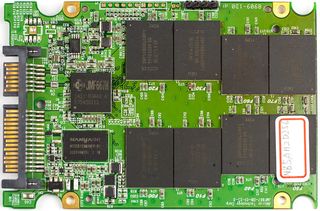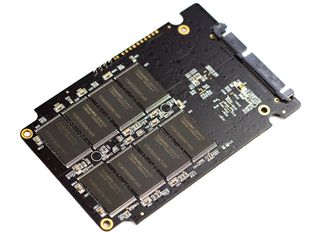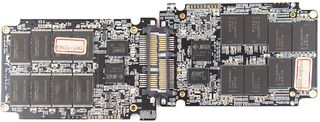JMicron Returns: The JMF667H Controller On Four Reference SSDs
It's rare that we get the chance to test SSDs before they hit production. But after waltzing with Silicon Motion's SM2246EN platform last year, JMicron offered us a handful of reference drives with different types of flash, all driven by the new JMF667H.
JMicron's JMF667H Steps Up To Redeem A Troubled Name
It's true that SATA 3.1 is slowly going out of vogue, and that next year you'll start seeing fewer SSDs leveraging it. They'll still be prolific, dominating the sales charts, but they won't be getting as much attention. PCI Express and SATA Express will start to pick up steam, demonstrate lower power consumption, and dominate the performance charts. They'll become the new sexy in solid-state storage. I think it's reasonable to expect that a mainstream laptop in 2015 or 2016 will employ a different interface and form factor than what we're testing today.
That makes now the golden age of SATA. From here, it's all downhill. Or is it?
After years of testing SATA-based drives, it's clear that most mainstream users are still served well by 6 Gb/s drives (even if the underlying technology is limited by the interface in certain ways). They're good with power, they're fast, and they're cheap. If you give me the choice between two solid SATA drives or one SATA Express-based repository, I'll take the RAID array in a desktop machine. The math works out a little differently for laptops. But even in that application, SATA is still smart.

That's because the power savings you can enable through a PCIe-based device isn't as good as the current crop of SATA SSDs. DevSlp was introduced with SATA 3.1, and the latest-generation notebooks are better for it. Even if your storage subsystem isn't DevSlp-capable, slumber states are still quite conservative.
If only for that reason, it's too early to signal the demise of SATA-based SSDs. In truth, none of the existing PCIe-based solutions in the M.2 form factor (at least the ones I've tested) radically improve your computing experience, particularly in the mobile space, where workloads are predictably milder.

All of that is my long-winded way of affirming that JMicron's power-efficient, cost-effective JMF667H SATA controller is a good idea. And the processor's building blocks can almost assuredly be applied to PCIe-based silicon down the road. In fact, I'm predicting that we see just that. But for now, JMicron's platform is a good mainstream solution.
Performance is actually breathtakingly-impressive paired to Toshiba's A19 flash. Don't expect too many drives leveraging that pricier combination, though. More relevant will be ONFi-compliant NAND in budget-oriented drives. That's too bad, since the A19-equipped reference platforms best the M6S and M6M in several of our benchmarks. Those Plextor drives utilize a Marvell four-channel controller and Toshiba's A19 flash as well, so the fight's pretty darned fair. In my mind, this demonstrates the 55 nm JMF667H to be competitive where it counts: actual workloads.
Stay on the Cutting Edge
Join the experts who read Tom's Hardware for the inside track on enthusiast PC tech news — and have for over 25 years. We'll send breaking news and in-depth reviews of CPUs, GPUs, AI, maker hardware and more straight to your inbox.

As we move forward, watching to see what the rest of 2014 has to offer storage mavens like myself, don't forget about JMicron. The Taiwanese firm isn't abandoning third-gen SATA, nor is neglecting the future. Against all odds, this company (and Silicon Motion) is looking to succeed where others have already failed. Now that we've tested its reference-class hardware, the real question becomes: how does the JMF667H compare Silicon Motion's SM2246EN? I know a good way to find out.
Current page: JMicron's JMF667H Steps Up To Redeem A Troubled Name
Prev Page Power Testing: Now With 73% More DevSlp-
Snipergod87 Page 6: "For every 1 GB the host asked to be written, Mushkin's drive is forced to write 1.05 GB."Reply
Mushkin drive?, To much copy paste. -
koolkei guys. please take a look at thisReply
http://www.tweaktown.com/reviews/6052/kingfast-c-drive-f8-series-240gb-ssd-review-cheapest-tested-240gb-drive-so-far/index.html
that's an actual SSD using this controller, and the price is........ a little more than surprising... -
pjmelect I remember their USB to IDE SATA chip. It caused data corruption every 4 GB or so when transferring data via the IDE interface. I have always been wary of their products since then.Reply -
tripleX "But we're not going to use theoretical corner cases (the sequential and random 4 KB benchmarks we just ran) to crown one configuration a winner and another a loser."Reply
A corner case is not sequential and random benchmarks. It is an engineering term that means, according to Wiki:
A corner case (or pathological case) is a problem or situation that occurs only outside of normal operating parameters—specifically one that manifests itself when multiple environmental variables or conditions are simultaneously at extreme levels, even though each parameter is within the specified range for that parameter.
-
g00ey JMicron has always made pretty shitty products so I won´'t buy any of these anytime soon...Reply -
2Be_or_Not2Be I, too, find it hard to want to purchase a drive from a manufacturer with such a lackluster history.Reply
One part of this article that also doesn't make sense: "Why four channels and not eight? Efficiency is one key motivator. Fewer channels facilitate a smaller ASIC, which can, in turn, be more power-friendly." Compare the size of the PCB to one like the Samsung 850 Pro. They aren't saving much in real estate (they are actually bigger than the Samsung boards), so it makes it hard to believe they're saving much in power here.
Most Popular

